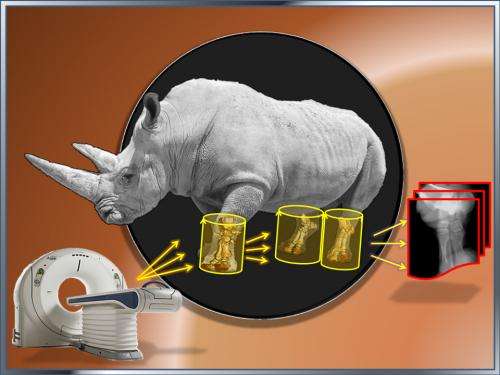Synchronised imaging techniques to diagnose rhinoceroses

A new imaging strategy of synchronising computed tomography with digital radiography helps to diagnose and initiate appropriate treatment of foot diseases in mega-vertebrates.
An international team of scientists led by the German Leibniz Institute of Zoo and Wildlife Research (IZW) developed and employed a new imaging strategy to diagnose foot diseases in Southern white and Indian rhinoceroses. This pioneering approach of combining and synchronising computed tomography (CT) with digital radiography (DR) endows wildlife clinicians with all-important tools: exposure protocols, modus operandi for foot positioning, reliable anatomical landmarks, species-related optimal radiographic views, and interpretation of normal anatomical and pathological aspects.
"We provide veterinary clinicians with concrete imaging techniques and substantial diagnostic tools that will facilitate straightforward implementation and interpretation of field radiographic images from rhinoceros feet taken worldwide", says Dr Gabriela Galateanu, joint first author of the study published in the scientific journal PLOS ONE.
In the absence of diagnostic tools and identification of the conditions that lead to bone-related foot pathologies, measures cannot be taken to prevent them and proper treatments cannot be initiated to alleviate suffering. Bearing in mind the severe impact of chronic foot disease on reproductive and general health status of captive rhinoceroses, the importance of eradicating such disorders in zoological gardens is of urgent priority. Zoological gardens play an important role in ex situ conservation efforts of rhinoceroses. "Therefore, it is our hope that following the publication of our study, foot radiographic examination will become a standard diagnostic procedure and, ideally, will also be periodically performed as a monitoring tool", commented Galateanu.
The study also provides, for the first time, taxa-specific unique radiographic views with improved bone visualisation over the traditional projections, and an assessment of the diagnostic value of every radiographic view, for the whole foot and separately for each podial bone.
After successful evolution during approximately 40 million years and a diversification into a substantial number of taxa, the Rhinocerotidae family is nowadays reduced to only five living species. Owing to habitat loss and heavy poaching for rhino horns, four of the five species are already on the brink of extinction. Being killed by poachers even in their protected sanctuaries, the future for some of the rhino species might lie solely in captivity.
Nevertheless, despite their long history in captivity, extending at least to Roman times, even the fate of some rhinoceros species in zoological collections is still uncertain. Captive rhinos are confronted with chronic foot diseases, a group of severe disorders previously thought to be confined to soft tissues and recently shown to include diverse severe bone pathologies.
Unfortunately, as radiography is the only foot imaging technique available to date for these charismatic species, veterinary clinicians lacked both a modus operandi and diagnostic evaluation tools. The results of this study will hopefully contribute to an improved welfare by helping to diagnose and focus treatment of foot diseases in these mega-vertebrates.
More information: Galateanu G, Hermes R, Saragusty J, Göritz F, Potier R, Mulot B, Maillot A, Etienne P, Bernardino R, Fernandes T, Mews J, Hildebrandt TB (2014): "Rhinoceros feet step out of a rule-of-thumb: a wildlife imaging pioneering approach of synchronized computed tomography-digital radiography." PLOS ONE, dx.plos.org/10.1371/journal.pone.0100415
Journal information: PLoS ONE
Provided by Forschungsverbund Berlin e.V. (FVB)

















